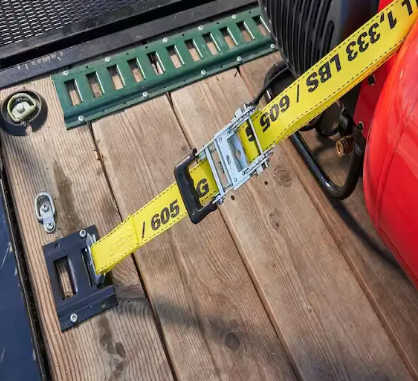1" x 10ft Cargo Ratchet Straps With J Hook
Cat:1″Ratchet Straps
Ratchet tie-down 1000 lbs breaking strengthEASY OPERATION AND QUICK RELEASE: The coated handle features a release lever for easy operation and release...
See DetailsE Track Ratchet Tie Downs are an indispensable safety fastening device in rail transportation, freight and logistics. E Track Ratchet Tie Downs are directly related to the safety of goods, equipment and personnel. Regular inspection and timely replacement of failed tie downs are a vital part of safety operating procedures. Understanding the key signs and situations in which E Track Ratchet Tie Downs need to be replaced can make the transportation process safer and more reliable.
Content
This is the most basic and most direct judgment standard. Once any of the following situations are found, stop using and replace it immediately.
Cuts, tears, holes: Any degree of surface damage will greatly reduce its tensile strength.
Severe wear: The edge or surface of the belt body is significantly thinned, fuzzed, or the fibers are broken due to friction.
Chemical corrosion or high temperature burns: It becomes brittle and hardened after contact with chemicals such as acids, alkalis, and solvents; or it melts and deforms after being burned at high temperatures.
Twisting or kinking: Severe permanent deformation can damage the internal structure of the material.

Cracks, breaks or deformation: Cracks are found on any metal part, or handles, shafts, etc. are bent or deformed.
Severe rust: The depth of rust seriously affects the strength of the metal and the flexibility of the mechanism, especially at key movable joints.
Failure of the ratchet mechanism: This is one of the most dangerous situations. It includes:
Jumping teeth: The handle cannot effectively engage the ratchet when tightening or loosening, causing it to slip.
Unable to lock: It cannot be maintained in the tightened position and will automatically rebound and loosen.
Unable to release: The release wrench (or button) fails and the binder cannot be released.
The end hook (Hook) used to fix to the E track is cracked, the opening becomes larger, or it is severely worn.
Cracks appear at the welding point.
Even if there is no obvious external damage, the following performance issues during use indicate the end of its lifespan and require replacement.
Decreased Tension Retention: After tightening, the tie-down quickly loosens under vibration, requiring frequent re-tightening. This indicates fatigue in the spring or locking mechanism inside the ratchet.
Abnormal Operation: The handle feels unusually stiff, sticky, or awkward when tightening, significantly different from the smooth feel of normal operation.
Previous Overload Use: If the tie-down has been subjected to forces far exceeding its rated working load (WLL) (for example, in an emergency situation where a load is nearly dislodged), even if it doesn't break immediately, internal damage may have occurred that is not visible to the naked eye and should be retired.
Manufacturer's Recommended Service Life: Many manufacturers provide a recommended maximum service life (e.g., 3 or 5 years) in their product specifications, typically starting from the date of initial use. Even if the strap appears intact, preventative replacement is recommended after reaching its service life, as the material will age and fatigue over time.
Failure of Regular Mandatory Inspection: In strict safety management systems (such as railways, aviation, and hazardous materials transport), tie-downs are subject to regular mandatory inspections, just like safety ropes. If the inspection reveals that the strength falls below the standard, it must be replaced immediately.
To detect problems promptly, a daily inspection system should be established:
Pre-use Inspection: Before each use, perform a quick inspection of the strap and metal components for obvious damage.
Regular In-depth Inspection: Perform a more thorough inspection at regular intervals (such as monthly or quarterly), including cleaning the ratchet mechanism for any contaminants.
Proper Records: Maintain a file for each tie-down, recording its purchase date, usage, inspection history, and replacement date.